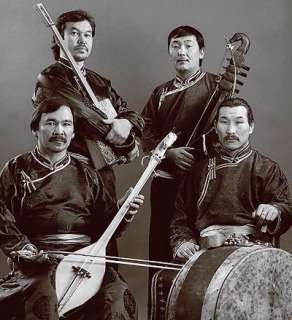|
Back
Two Views of Heaven New York
Zankel Hall, Carnegie Hall
04/23/2014 -
collected stories II: spirit
Songs by Huun-Huur-Tu
Arvo Pärt: : Passio
Kaigal-ool Khovalyg, Radic Tuyulyush, Sayan Bapa, Alexey Saryglar (Throat-singers) Nicholas Phan (Tenor), Dashon Burton (Baritone), Renée Anne Louprette (Organ), ToniMarie Marchioni (Oboe), Shelley Monroe Huang (Bassoon), Emily Popham Gillins (Violin), Saeunn Thosteindottir (Cello)
TENET, Jolle Greenleaf (Artistic Director), Julian Wachner (Conductor)
David Lang (Curator)

Huun-Huur-Tu (© Courtesy of the Artists)
Composer David Lang’s six days of “collected stories” probably didn’t include this story.
Four young men from a remote community somewhere in Siberia without a single day in a conservatory artistically slaughtered an elite sophiticated composer whose pedigree places him in the halcyon of the Great Ones.
That was the story from yesterday, when Huun-Hur-Tu, four khoomei (throat-singers) from the nominally independent country of Tuva in Siberia produced music which was far far far more interesting than their singular vocal technique would have promised. Although “singular” doesn’t begin to describe their throat-singing.
In the simplest form, the singing, yes, comes from the throat, a bass drone going down, I would say, to an A below low C. But somehow, simultaneously this drone divides up into two different phenomena. First, with the throat-droning is an overtone or series of overtones which go up into the mouth. Then, even these overtones and drones produce the most diverse sounds and different combinations of sounds. In fact (and it was impossible to make a friend believe this when I explained it to him), the sounds can be whistles or birdcalls or flutes.
They even have a counterpoint, a polychordal, polytextural music which smacks of both medieval isorhythmic textures, folk tunes and (gulp) bagpipe drone-melody music.
Now add to this the incredible variety of instruments which the Tuvans play. They have their own jews-harp, which of course also uses the mouth as a sound-box), they have a variety of simple, complex and modern guitars. The latter were added inevitably when they began to travel internationally. But they do not use the guitar for “western” sounds. Rather it is plucked or strummed to give more texture to their own music. They have a bass flute which–when played with the bass drum–has the kind of sounds which Harry Partch might have drooled at.
Mr. Partch’s music was played the first day of the collected stories, and those sounds made a fitting counterpoint to the Huun-Huur-Tu. The title, by the way, has a meaning which any painter would enjoy: “Separation of Light Rays on the Prairie.”
For yes, the Tuvans, from southern Siberia, live out on the prairie, as herders, agriculturalists, breeders of reindeer. Indeed, the reindeer gives an indication of their music, for when not “throat-singing”, the Tuvans have a jingly-jangly series of melodies very much like Lappish melodies I used to hear in northern Finland.
But the have more than simple melodies. For at times, the bass drum provides a rhythmic ostinato–a loud ostinato–which gives a power to these musicians that is quite unfathomable.
They were extraordinary. Their eight-odd different works with different combinations of instruments was equally stimulating to both artists and audience.
The surprise of their extraordinary presence was that I had told a guest visiting from England that he might have to “suffer through” the Siberians to get to the “good stuff” from Arvo Pärt.
How perverse was my estimation. I love listening to Pärt in small doses, or in different musics with different ensembles. His Fratres deserves to be on that Pop best-seller list which includes Barber’s Adagio and Strauss’s Zarathustra, and his own works, when played in a church, are quite mystical.
But last night, his 75-minute uninterrupted music called Passio was anything but potent.
This was St. John’s telling of the Crucifixion, and it was told in with thin instrumental pieces, monotonous recitatives by the eight-voiced TENET chorus, four Evangelists, one Jesus (the unfailingly sonorous Dashon Burton) and one Pontius Pilate (a lulling tenor, Nicholas Phan.)
Such lulling and sonority would have been boring in many works, but in Passio it went right into Pärt’s spirit that “In the beginning was the Word” and not much happened after that.
For a few sections, Pärt almost made some emotional connections. “Barrabas!” was, like the Bach Passion, shouted out. “Crucify him” and “Hail, King of the Jews” actually produced some feeling. And finally, Pärt cheated a bit at the end with a chorale and a bourgeois perfect triadic chord.
We’ve all heard plenty of mesmeric music in our lives, but Passio had no more hypnotic mysticism than a priest giving a dreary set of homilies in a foreign tongue.
The artists from Tuva, thank Shaman, gave the music of joy, excitement and Passion with a final N.
Harry Rolnick
|